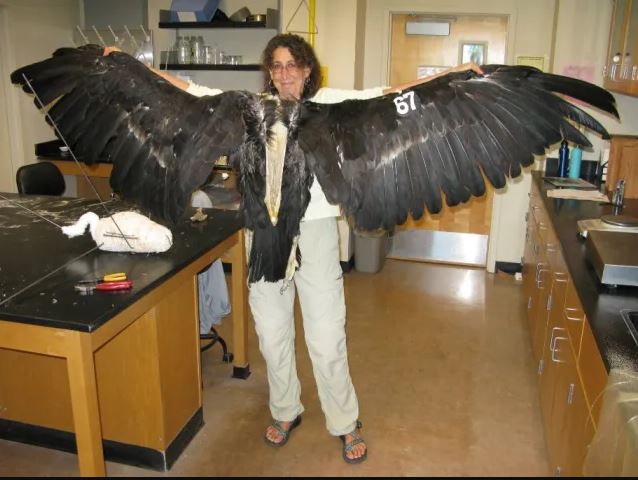How Big is the California Condor Wingspan? A Comprehensive Guide
The california condor wingspan can reach up to 9.8 feet, making it one of the largest birds in north america. This endangered species has been the focus of conservation efforts for decades due to habitat loss and hunting.
The california condor is a remarkable bird with a wingspan that stretches nearly 10 feet. It is an endangered species that has faced challenges due to habitat loss and hunting. The bird is part of a carefully planned conservation program that has helped to stabilize its population over the years.
In this comprehensive guide, we’ll take a closer look at the california condor, its habitat, behavior, and the efforts being made to protect it from extinction. We’ll also examine the bird’s impressive wingspan and how it helps the species thrive in its natural habitat.
Credit: en.wikipedia.org
What Is The California Condor?
The california condor is a remarkable bird that is native to north america. With a wingspan of up to 10 feet, it is one of the largest birds in the world. Below, we will discuss the key characteristics and current population status of this magnificent creature.
A Brief Background Of The California Condor
- The california condor is part of the new world vulture family and is related to the andean condor and the king vulture.
- Due to habitat loss, hunting, and lead poisoning, the california condor almost became extinct in the late 20th century.
- Extensive conservation efforts, including a captive breeding program and the banning of lead ammunition, have helped to increase the population of the california condor in recent years.
Physical Characteristics Of The California Condor
- The california condor has a wingspan of up to 10 feet, making it one of the largest birds in the world.
- It has a distinctive bald head, which helps to prevent bacteria from accumulating from feeding on carrion.
- California condors have black feathers that cover most of their body, with white patches around the wings and neck.
- Male and female california condors look similar, but males are slightly larger than females.
The Current Population Status Of The California Condor
- According to the latest count, there are around 500 california condors in the world, including both captive and wild populations.
- The majority of these birds are in california, with smaller populations in arizona, utah, and baja california.
- Although the population has increased, habitat loss and lead poisoning are still significant threats to the california condor’s survival.
The california condor is a magnificent bird with a fascinating history. Conservation efforts have helped to save this species from extinction, but there is still a long way to go. By learning more about these birds, we can help to protect them for future generations.
Why Is The Wingspan Of The California Condor Important?
The california condor is one of the largest soaring birds in north america. With a wingspan of up to 10 feet, it is an impressive sight to behold. The wingspan of the california condor is just one aspect of their biology and ecology that make them unique and significant.
In this post, we’ll explore why the wingspan of the california condor is so important.
The Role Of Wingspan In Bird Biology And Ecology
Birds have evolved to have a wide variety of wing shapes and sizes. These variations allow birds to thrive in different environments and perform various tasks such as soaring, diving, hovering, and flapping flight. Wing morphology plays a critical role in bird biology and ecology, affecting everything from food acquisition to mating rituals.
Specific Reasons For The Significance Of The California Condor Wingspan
The california condor’s wingspan is exceptional, and it is vital to comprehend the symbolism behind it. Here are some of the specific reasons why this wingspan is so significant:
- Efficient soaring: The california condor’s wingspan allows it to soar high and glide efficiently, using minimal energy. This is crucial as it enables them to cover vast areas in search of food and other resources.
- Thermoregulation: The large wingspan allows the condor to regulate its body temperature by adjusting the amount of surface area exposed to the sun. This strategy is vital as it helps them combat the extreme heat of their habitat.
- Long-distance movement: The large wingspan makes it possible for california condors to cover long distances, allowing them to migrate long distances, move between different habitats, and relocate to breeding grounds.
- Superior foraging abilities: The soaring ability and spectacular wingspan of the california condor make them efficient foragers, allowing them to detect the carcasses of large animals at great distances. This gives them a unique competitive advantage over other scavengers.
The wingspan of the california condor is more than just a simple anatomical measurement. It plays an integral role in their biology and ecology, contributing to their soaring ability, thermoregulation, long-distance movement, and superior foraging ability. Understanding the significance of the california condor’s wingspan helps us appreciate the unique adaptations that make this species so remarkable.
How Wide Is The Wingspan Of The California Condor?
The california condor is a remarkable bird, and its wingspan is no exception. These magnificent creatures are a true testament to the grandeur of nature, and it’s only right to give them the recognition they deserve. In this blog post, we’ll answer the question on every bird enthusiast’s mind: how big is the california condor wingspan?
Description Of The Wingspan Of The California Condor
The wingspan of the california condor is truly impressive, measuring up to 9. 8 feet (3 meters) in length! This wingspan is larger than that of any other north american land bird, and it’s not hard to see why. When you see a california condor soaring through the sky, it’s easy to be awed by the sheer size and power of their wings.
Comparison Of California Condor Wingspan To Other Bird Species
To put the wingspan of the california condor into perspective, let’s compare it to other bird species:
- Bald eagle: The wingspan of the bald eagle is typically between 6 and 7 feet (1.8-2.1 meters), making it significantly smaller than the california condor.
- Golden eagle: The golden eagle has a wingspan that ranges from 6 to 7.5 feet (1.8-2.3 meters), which puts it roughly in the same category as the bald eagle.
- Andean condor: The andean condor, which is closely related to the california condor, has a wingspan that ranges from 9.2 to 10.5 feet (2.8-3.2 meters). While the andean condor’s wingspan is larger than the california condor’s, it’s important to note that the andean condor is also a much larger bird overall.
Factors Affecting The Size Of The California Condor Wingspan
There are several factors that can affect the size of the california condor‘s wingspan. Here are some of the key factors:
- Genetics: Like all living creatures, the california condor’s wingspan is largely determined by genetics. Strong genetic traits can lead to a larger wingspan.
- Habitat: The environment in which the california condor lives can have an impact on its wingspan. Birds that live in areas with open skies, like the grand canyon, tend to have larger wingspans.
- Diet: The california condor’s diet can also affect its wingspan. Birds that have access to a varied diet with high protein content are more likely to have a larger wingspan.
The wingspan of the california condor is truly remarkable and a testament to the beauty and power of nature. By understanding the factors that affect its size, we can gain a deeper appreciation for these magnificent birds.
How Far Does The California Condor Fly?
The california condor is a fascinating bird that has captured our attention for many reasons. With their impressive wingspan and unique features, it’s not surprising that people have many questions about these animals. One of the most common questions is about how far the california condor can fly.
In this section, we will explore the different factors that affect their flying range and the challenges that they face.
Information On The Flying Range Of The California Condor
- California condors are able to fly great distances, with some individuals being recorded to travel over 100 miles in a single day.
- The average distance covered by these birds is around 150 miles per day, which allows them to forage for food and explore large territories.
- The total flying range of a california condor can vary greatly depending on the individual bird’s age, sex, and overall health.
Factors Affecting The Flying Range Of The California Condor
- Food availability is a significant factor affecting the flying range of california condors. These birds need to consume a significant amount of food, between 1-2 pounds per day, and may travel great distances to find suitable food sources.
- Temperature and wind conditions can also affect the flight patterns of the california condor, with high winds and cold temperatures decreasing their flying range.
- Habitat fragmentation and the loss of suitable foraging areas can also affect the flying range of these birds. As human activity encroaches on the habitats of these birds, they may need to travel further to find the resources they need.
Challenges Faced By The California Condor During Flight
- The california condor has a large wingspan of up to 9.8 feet, which can make them vulnerable to strong winds and turbulence.
- In addition, the california condor is a heavy bird, with an average weight of around 20 pounds. This weight can make it difficult for them to gain altitude and fly for extended periods.
- Loss of habitat and the challenges associated with finding enough food to sustain their large size can also make flying more difficult for these birds.
The california condor’s flying range is affected by a variety of factors, including food availability, temperature, habitat fragmentation, wind conditions, and the challenges associated with their large wing size and weight. Despite these challenges, these birds are still able to travel great distances and sustain themselves in the wild.
Understanding the factors affecting their flight can help us better protect these magnificent birds and ensure their continued survival.
Frequently Asked Questions For How Big Is The California Condor Wingspan? A Comprehensive Guide
What Is The Wingspan Of A California Condor?
The california condor has an average wingspan of 9. 5 ft and can weigh over 25 pounds.
How Do California Condor Wings Compare To Other Birds?
The california condor has one of the largest wingspans of any bird in north america and the world.
How Does The California Condor Use Its Large Wingspan?
The california condor uses its large wingspan to soar through the air for hours searching for carrion to feed upon.
How Does The Wingspan Of A Juvenile California Condor Compare To An Adult?
Juvenile california condors have a wingspan around 6 feet, about two-thirds that of an adult.
Can California Condor Wingspan Size Affect Their Flight?
California condors have large wingspans to support their massive bodies and glide through the air with ease.
Conclusion
The wingspan of the california condor is an impressive feat of nature that has captured the attention of experts and enthusiasts alike. As we’ve seen throughout this comprehensive guide, these birds have an incredible wingspan that can reach up to 9.
8 feet (3 meters) in length, making them one of the largest birds in north america. While their size and beauty may be awe-inspiring, it’s important to remember that these animals are also a crucial part of their ecosystems, helping to maintain the balance of nature.
Protecting the habitats of the california condor and ensuring their continued conservation efforts is essential for the survival of this magnificent species. With further research and education, we can work towards a future where these birds can thrive and continue to amaze us with their stunning wingspans.








